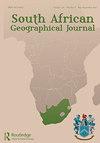A closer look at mineral aerosol emissions from the Makgadikgadi Pans, Botswana, using automated SEM-EDS (QEMSCAN®)
IF 1.4
4区 社会学
Q3 GEOGRAPHY
引用次数: 4
Abstract
ABSTRACT This paper demonstrates the use of Quantitative Evaluation of Minerals by SCANning electron microscopy (QEMSCAN®), an automated scanning microscopy technique, which combines scanning electron microscopy (SEM) and energy dispersive spectroscopy (EDS), providing ultra-fast analysis of particle grains at a micron-scale resolution. We evaluate its application in aerosol studies by comparing surface and airborne samples from the Makgadikgadi Pan in Botswana. The playa is a major global dust emitter and its aerosols have a widespread effect on atmospheric, biological and terrestrial processes. Sampling was conducted at a carefully selected surface location and associated BSNE dust trap stack at 0.25, 0.5, 0.85 1.65 meters. The dominant minerals identified here are quartz, halite, thernadite, mica, calcite and feldspar. Surface sample results from QEMSCAN are in line with other forms of elemental and mineralogical analyses. When comparing surface samples with elevated trap samples, we noted a fining and fractionation during grain entrainment, resulting in a compositional shift with height. We also observed some ultra-fine fraction losses from the BSNE traps. Overall, the single location here establishes the link between fluvial playa basin inputs, sediment storage, evaporation products and aeolian losses and outputs from a dry lake surface, not unlike semi-arid evaporative dust sources elsewhere.使用自动SEM-EDS (QEMSCAN®)仔细观察博茨瓦纳Makgadikgadi pan的矿物气溶胶排放
摘要:本文介绍了利用扫描电子显微镜(QEMSCAN®)对矿物进行定量评价,这是一种自动扫描显微镜技术,它结合了扫描电子显微镜(SEM)和能量色散光谱(EDS),提供了微米级分辨率的超快速颗粒分析。我们通过比较博茨瓦纳Makgadikgadi Pan的地表和空气样本来评估其在气溶胶研究中的应用。盐湖是全球主要的粉尘排放源,其气溶胶对大气、生物和陆地过程具有广泛的影响。采样在精心选择的地表位置和相关的BSNE集尘器堆0.25,0.5,0.85 1.65米处进行。主要矿物有石英、岩盐、热钠石、云母、方解石和长石。QEMSCAN的表面样品结果与其他形式的元素和矿物学分析一致。当将表面样品与升高的陷阱样品进行比较时,我们注意到颗粒夹带过程中的细化和分馏,导致成分随高度变化。我们还观察到了BSNE圈闭中一些超细组分的损失。总的来说,这里的单一地点建立了河流playa盆地输入、沉积物储存、蒸发产物和风沙损失之间的联系,并从干燥的湖面输出,这与其他地方的半干旱蒸发沙源没有什么不同。
本文章由计算机程序翻译,如有差异,请以英文原文为准。
求助全文
约1分钟内获得全文
求助全文
来源期刊

South African Geographical Journal
GEOGRAPHY-
CiteScore
3.40
自引率
7.10%
发文量
25
期刊介绍:
The South African Geographical Journal was founded in 1917 and is the flagship journal of the Society of South African Geographers. The journal aims at using southern Africa as a region from, and through, which to communicate geographic knowledge and to engage with issues and themes relevant to the discipline. The journal is a forum for papers of a high academic quality and welcomes papers dealing with philosophical and methodological issues and topics of an international scope that are significant for the region and the African continent, including: Climate change Environmental studies Development Governance and policy Physical and urban Geography Human Geography Sustainability Tourism GIS and remote sensing
 求助内容:
求助内容: 应助结果提醒方式:
应助结果提醒方式:


